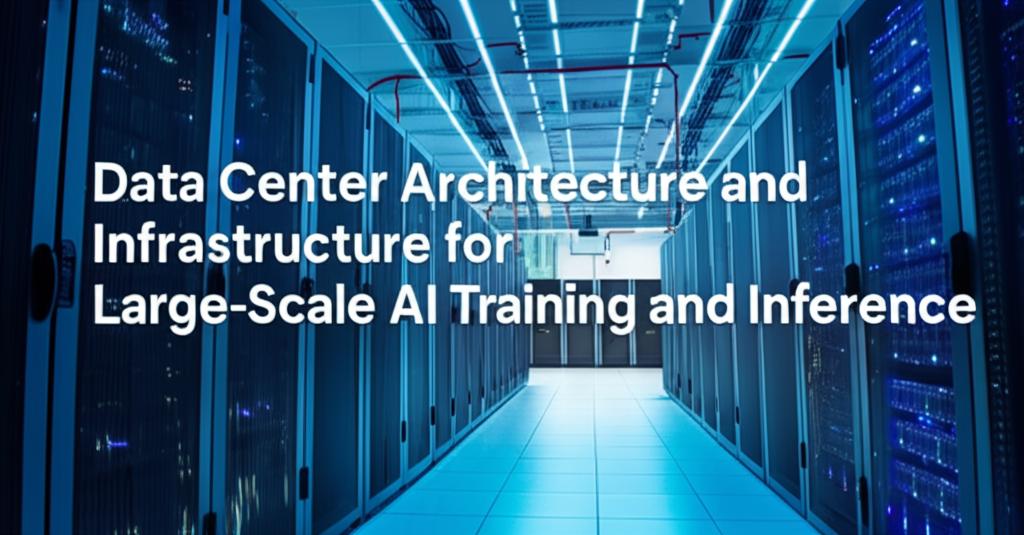The rise of large-scale Artificial Intelligence (AI) workloads, particularly for training complex models and deploying real-time inference, is fundamentally reshaping data center architecture and infrastructure. Traditional data centers, often designed around CPU-centric tasks with moderate power densities, are ill-equipped to handle the immense computational, power, cooling, and networking demands of modern AI.
Shift to Specialized Compute:AI, especially deep learning, relies heavily on parallel processing. This has driven a massive shift from relying solely on Central Processing Units (CPUs) to incorporating Graphics Processing Units (GPUs) as the primary workhorses. GPUs, designed for handling simultaneous calculations, are vastly more efficient for the matrix multiplications central to AI model training and inference. Beyond GPUs, specialized accelerators like Tensor Processing Units (TPUs) and Neural Processing Units (NPUs) are increasingly common, offering hardware optimized for specific AI operations, further boosting performance and efficiency for tasks like deep learning training.
Unprecedented Power and Cooling Demands:AI infrastructure, particularly dense GPU clusters, consumes significantly more power than traditional server racks. Average power densities have surged, climbing from around 8-15 kW per rack just a few years ago to routinely exceeding 40 kW, with high-performance configurations demanding 100 kW to over 140 kW per rack. This exponential increase necessitates major upgrades:
- Power Delivery: Data centers are adopting higher voltage distribution systems (e.g., 415V instead of 208V, or 48V DC at the rack level) to improve efficiency and handle higher loads. Larger Power Distribution Units (PDUs) and robust backup power systems are becoming standard, although some AI training workloads might tolerate lower power redundancy compared to mission-critical business applications.
- Advanced Cooling: The intense heat generated by high-density racks overwhelms traditional air cooling. Consequently, liquid cooling is rapidly becoming essential. Common solutions include Rear Door Heat Exchangers (RDHX), Direct-to-Chip (DTC) liquid cooling (where coolant directly touches the processors), and full Immersion Cooling (submerging hardware in dielectric fluid). The choice often depends on the specific GPU models and rack density.
AI workloads generate massive data flows, demanding sophisticated network architectures:
- Training: Requires extremely high bandwidth and low-latency east-west traffic (server-to-server communication within the cluster). GPUs constantly exchange large datasets during distributed training. Architectures like Fat-Tree or other non-blocking designs using high-speed interconnects (e.g., 400Gbps/800Gbps Ethernet or InfiniBand) are crucial to prevent bottlenecks and minimize training time.
- Inference: While still needing high performance, inference often prioritizes low latency north-south traffic (communication between users/applications and the data center). Although inference tasks might be less power-intensive per instance than training, the sheer scale of deployment means overall network capacity and responsiveness remain critical, especially for real-time applications. Edge data centers are often used for inference to reduce latency by being closer to end-users.
AI necessitates fast, scalable storage systems capable of handling enormous datasets for training and rapid data retrieval for inference. High-speed solutions like distributed file systems and object storage are vital to ensure data access doesn't become a bottleneck, particularly during the data-intensive training phase. Storage must scale easily as datasets and models continue to grow.
Architectural Design Trends:- AI Factories: Purpose-built, often massive scale facilities designed specifically for AI workloads, incorporating integrated high-density power, advanced liquid cooling, and optimized networking from the ground up.
- Modular Design: Using prefabricated modules for IT, power, and cooling allows for faster deployment, scalability, and flexibility as AI requirements evolve.
- Hybrid Approaches: Leveraging cloud resources alongside on-premises infrastructure provides flexibility and scalability, though concerns about data privacy, cost, and vendor lock-in drive many enterprises towards dedicated or colocation solutions for sensitive workloads.
- Site Selection: Proximity to cheap, abundant, and potentially renewable power sources is becoming a primary driver for locating new AI data centers, sometimes outweighing the traditional importance of network latency to major population centers, especially for training-focused facilities.
While sharing core components, the emphasis differs:
- Training Clusters: Focus on maximizing raw compute power (dense GPUs), ultra-high bandwidth east-west networking, massive power and sophisticated cooling. Can often be centralized where power is available.
- Inference Platforms: Optimize for low latency and high throughput. May use less powerful (but numerous) GPUs/CPUs/accelerators. Network focus is often north-south. Often benefits from geographically distributed deployment (edge computing) to be closer to users.
In conclusion, supporting large-scale AI training and inference demands a paradigm shift in data center design. It requires a holistic approach focusing on specialized high-performance compute, dramatically increased power delivery and density, advanced liquid cooling technologies, high-bandwidth low-latency networking tailored to specific workload patterns, and scalable storage, all built within flexible and often modular architectural frameworks.

